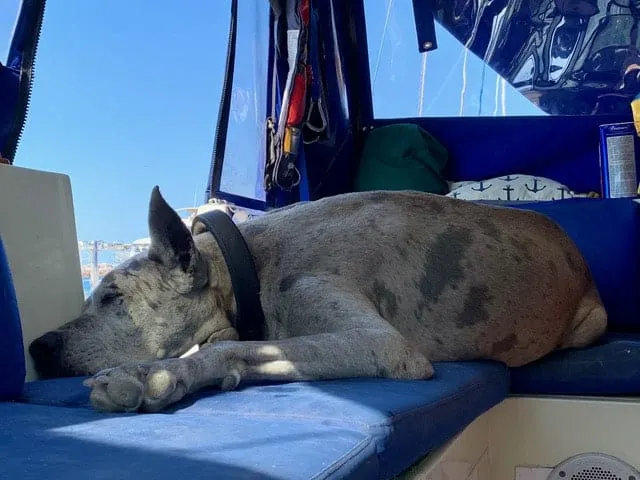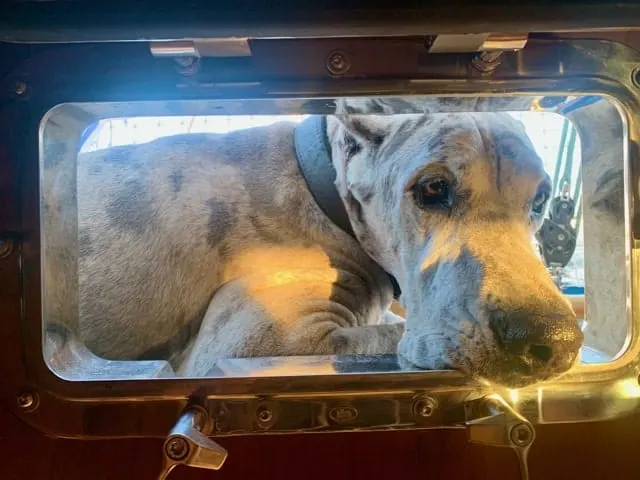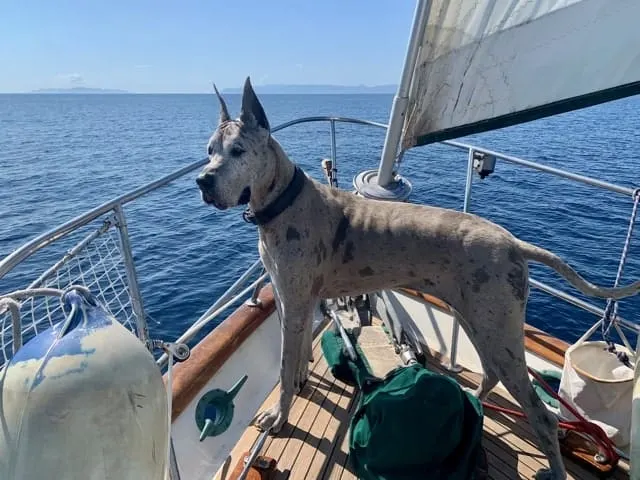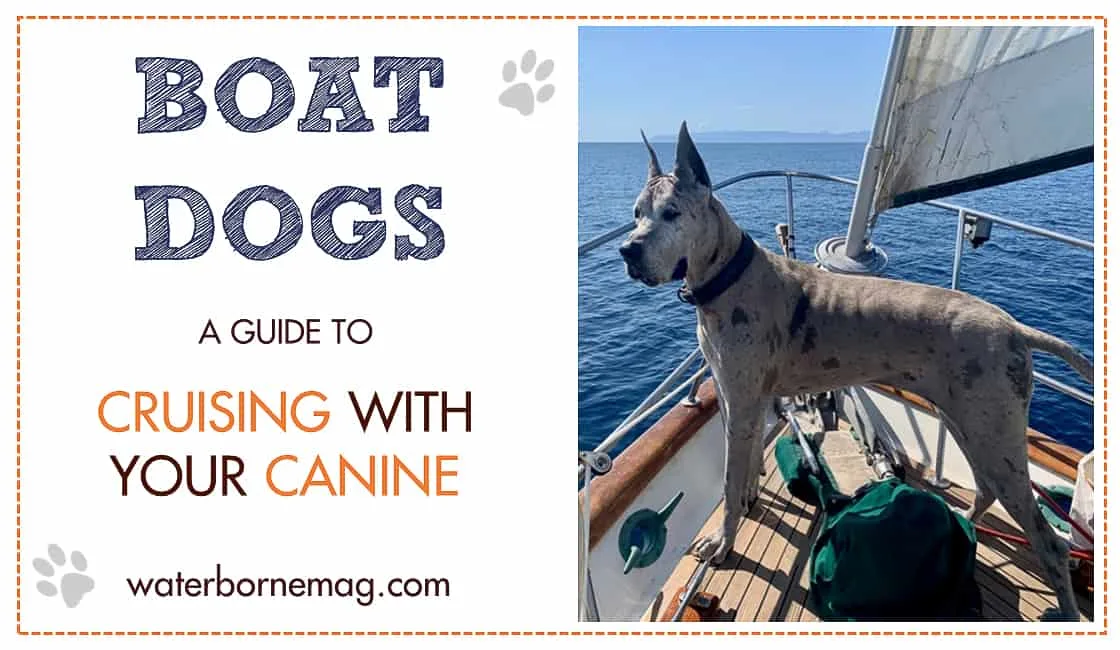HOW TO GO CRUISING WITH A DOG
“Go big or go home,” a saying we perhaps took too literally in selecting our four-legged, 130 lb. boat dog. We love our Great Dane and we love our boat. So, when the opportunity arose to cruise full-time, we decided to take the entire family, including the Dane.
Space is at a premium when living on a boat but we were willing to sacrifice some room and (ahem!) cleanliness aboard our 51-footer for our beloved Quincy. Despite her size, she really doesn’t need a ton of space as long as she gets to stretch her long, gangly legs once in a while.
We’ve been blessed with how well she’s adapted to boat life and believe that, as with anything, you have to make the decisions that are best for your family and lifestyle. Here is a rundown of considerations and lessons learned for anyone who wants to bring their dog on the open seas.
SAFETY FIRST
We have a boating safety rule that applies to both humans and canine crew: keep all crewmembers on the boat. This is a simple, yet paramount principle, as unexpected recovery of a crewmember puts all crew at risk.
Dog lifejacket and safety gear
We started by putting Quincy in a dog life jacket while underway. However, it was very bulky, appeared uncomfortable, and made navigating our narrow decks more precarious.
Presently we rely on other safety features and keep a dog life jacket on standby for heavy sea states. We keep her in a collar so that we have something to restrain her when we encounter huge pods of dolphins or the occasional dinghy or paddleboarder.
Netting and lifelines extend along the perimeter of our boat with slots for entry and exit on the port and starboard sides.
Do dogs need a life jacket?
While dogs are not legally required to wear a life jacket, outfitting your dog with one is generally a good idea. Large and small dogs alike can get hurt, fall overboard, get caught in currents, or may not be strong swimmers. A doggie life jacket will keep their head above water and could potentially save their life.
Dog overboard
The one time the netting and lifelines failed to keep our dog on board was when she became overexcited at the prospect of a trip to shore. We had failed to clip together the starboard entry point at the bottom.
KERPLUUUNKKKKK! Our first dog overboard, thankfully at anchor.
Within seconds we confirmed what we believed to be true … she CAN indeed swim! I jumped in with a floatation device that I propped under her belly for support until we could manage a way to get her on the swim step.
While we hope to not have to go through a dog overboard again, we feel prepared for it. We now have:
- A clip at the entry points that prevents a dog overboard at sea and escape attempts while on the dock
- An easily accessible flexible flotation device
- A dog lifejacket with handles in place to hoist her onboard
- A dog overboard plan/procedure that keeps rescuers safe
Abandoning ship
Our dog is a crew member too and at 130 lbs. we took her into account when we purchased our 8-man life raft. We also keep her medication and a spare pair of socks in the ditch bag.
Deciding whether or not to bring a pet with you in the event of abandoning ship is one of several tough decisions pet owners need to anticipate making. Should we ever find ourselves in this situation, we’d make the effort – she deserves it.

Photo credit: LiveFree2SailFast.com
VETERINARY AND MEDICAL
Find a vet to help you plan for cruising with a dog
Find an awesome vet before going cruising with a dog. We lucked out by being referred to Dr. Charlotte Frank of Paws4Shots by her dog daycare, Camp Run-A-Mutt. She listened to what we were about to do and helped us plan for anticipated medical needs.
I also recommend researching local vets in the areas that you plan to visit. This can be helpful for getting immunizations and other preventative healthcare, as well as dealing with unanticipated emergencies.
Get a travel certificate of health
We made sure to get Quincy a USDA International Travel Certificate of Health before taking her abroad (though this is no longer required for travel to Mexico). Do your research before you leave, obtain any necessary import permits, and be sure you meet country requirements for bringing your pet along.
Have a first aid kit and know how to use it
I purchased Where There is No Pet Doctor by David W, LaVigne as our onboard veterinary medicine guide. Having a guide helps us answer questions like: “Do I need to change plans to get her to a vet or can I manage this onboard with what I have?”
Common medical issues for a dog on a boat
Common medical concerns for boat dogs include heat injury and sea sickness.
Heat injury
Many of the places we’ve traveled to are tropical, warm (OK, hot) climates and we had to consider how to help her stay cool. We don’t take heat exhaustion lightly. We have ice cubes, a spray bottle, fans, ample fresh water, and plenty of shade for cooling her down.
Sea sickness
If we’re rolling along in a difficult sea state, I don’t need a large vomiting, anxious, dehydrated dog to complicate things. On passages that involve excessive heeling or bashing, I give her sea sickness medication and she eventually settles into her spot to get some rest.
TRANSITIONING A BOAT DOG TO LIFE AFLOAT
We had no idea how Quincy would do living on a boat. Back in San Diego, I had nightmares leading up to her moving aboard. I could see her falling overboard or jumping below and breaking a leg.
The reality though is that dogs aren’t stupid – although with Great Danes there are times when I wonder! Just like any new home, they adapt if you introduce them in a calm and safe manner. We gave her time to explore her new environment and encouraged her to take over the enclosed cockpit as her new home.
Boat purchasing considerations
We had our dog in mind when we purchased our boat, Tulum V, a 1977 Aleutian 51 Ketch. For example, the low-angled steps at the stern entrance (which gave our dog easy access to below decks) were definitely a selling point.
Planning for your dog’s personality and behavioral triggers
Quincy can be an excitable dog and as such, there are safety considerations for the rest of the crew on board. We know her triggers, but sometimes cannot anticipate the trigger early enough to intervene.
- Everyone onboard needs to be conscious of her size, strength, and will, especially when she wants to protect us from a perceived threat
- We’ve learned not to place ourselves outboard of her when grabbing the leash for a shore excursion (one sure trigger)
- We know she goes nuts when we unfurl the sails or if she sees a sail luffing in the wind (another trigger)
All our feet bear the scars of standing in her way on prior episodes. Diversion, calming techniques, and planning ahead help keep our entire crew safe. If we have guests aboard, we also brief them on what to expect. For example, her welcoming vocal antics bellowing across the anchorage.

Photo credit: LiveFree2SailFast.com
POTTY TRAINING
We have a potty mat placed on the bow which she hits 100% of the time with extreme accuracy… yeah right!
We lived on the dock with Quincy for about a year before leaving to cruise and until we left, she had never gone to the bathroom on the boat. Knowing this would be a challenging, yet critical, behavior to learn, we had her doggie day care give us a used but washed plot of fake grass to help familiarize her with the new routine.
We placed it on the bow, away from her feeding and living space, in a spot that was easily visible from the cockpit while underway. Within 24 hours of a passage, she began using it and we gave her extreme praise.
We have extra mats onboard because despite constant cleaning, they wear out and get gross.
Here are some recipes for affordable homemade deck cleaners to help you stay on top of the mess.
When docked or anchored near shore, we make all efforts to take her to dry land and avoid using the potty mat. We also keep biodegradable bags with us for cleanup.
She has adapted well to both situations. We stow her potty mat while docked to signal to her that it is not time to use it. We’ve had very few incidents. She’s vocal and lets us know when it’s time to go out!
KENNELING AND TRANSPORTATION
Over the year, we’ve hauled out our boat, spent nights out on the town as a family, and needed to travel home, so locating a reliable dog sitting service in larger ports was essential.
While we found we could safely leave her on the boat at anchor for a night out, the same did not apply in the marina. We would inevitably have a large Marmaduke lurching down the dock toward us as we tried to sneak out without her.
We found kenneling or dog sitting services through word-of-mouth, cruiser resource guides, and advertisements at the marinas. We didn’t obtain information through veterinarians, but believe this could be another resource for kenneling.
Locating a kennel or private home that had availability for a large dog was step one, the next step was transportation – Quincy is not exactly a lap dog even though she thinks she is.
We were fortunate to find various means of transportation for Quincy: dog sitters who were willing to transport her for an additional fee, a for-hire driver who owned large dogs. Sometimes we rented our own vehicle.
The time away on shore was a win-win. She could socialize off leash with other canines, stretch her legs and enjoy some A/C, while we traveled or took care of essential projects.

Photo credit: LiveFree2SailFast.com
FOOD AND SUPPLEMENTS
The expectation that we could keep her on her high-quality food throughout our travels was unrealistic, although you’d be impressed with how many bags of dog food we packed.
It was easier to adapt her to food that was readily available and find a powdered nutritional supplement that was simple to order and store on board. We also supplement her diet with rice and chicken and, given her size and age, give her Dasequin regularly for joint support.
RECREATION AND EXERCISE
Quincy enjoys exploring her new surroundings ashore just as much as we do. She will sometimes sprint like a freight train for about 100 yards on the beaches and other times just saunter through the water, cooling off her belly as she goes.
If we don’t prevent it, she’ll drink salt water. We knew this before leaving based on several dog-beach experiences. If left unmanaged, the insult to her organs can be deadly.
We make sure that she stays hydrated throughout the day and entice her to drink by throwing an ice cube in her water – whatever works. We bring a water bottle each time we go to shore and have developed a system where one of us manages the dog with a water bottle while the other secures the dinghy.
The few times we were not as diligent about hydration, we saw immediate effects. She puked all over the cockpit which was likely a product of salt water intake, heat, and sitting in a rolly anchorage.
Needless to say, shore excursions with Quincy in the Mexico heat are short-lived with few exceptions. She’ll even let us know she’s ready to go back by jumping in the dinghy.
We keep a watchful eye for stingrays, stone fish, or crabs as she’s oblivious to these hidden dangers. We’ve also learned to be careful in our own exploration of slippery rocks at low tide as she will inevitably try to follow us and we’d like to keep her joints intact.
National parks and restricted areas
Many of the islands we wanted to visit were within national park boundaries where pets were not permitted ashore. While Quincy can last for days without hitting shore, we try to balance our time in the islands with ports where we can safely and legally get her to shore.
COVID restrictions in 2020 included beach closures which further limited these excursions. When quarantine and stay-at-home orders reached their peak, we took ridiculous “walks” around the deck and played with her as best we could – she did fine.
Animal encounters
We are always on the lookout for animal encounters both ashore and on the ocean. Leashed dogs are a rarity here in Mexico. Dogs, cats, cows, iguanas, and burros roam freely.
Given her size and excitable temperament, we keep Quincy on a leash (aside from remote coves). Off-leash, in a free-range daycare environment, she does just fine with both canines and felines but the unexpected animals we encounter while walking on a leash are just too much excitement.
While underway, she loves watching dolphin pods, wagging her tail and looking for them at the bow long after they’re gone. She’s also watched jumping rays and humpback whales.
I will never forget the first time she actually heard a humpback whale’s prolonged exhale in the early morning stillness of Banderas Bay. She froze, I believe, at the realization that there was something much larger than dolphins in her neck of the woods!
We’ve had flying fish and jumping squid come aboard in the middle of night passages. If we don’t want her enjoying an extra treat, we need to be the first to survey the decks as the sun comes up in the morning.
Overall, it’s fun to observe her curiosity about this new underwater world. We try to approach the newness in a calm manner, although it is still difficult for me to contain my excitement at the sight of a humpback whale breeching within our vicinity!

SAILING WITH A DOG ON PASSAGE
Sailing with a dog on an overnight crossing requires some planning. For example, we make sure to walk her forward to her potty mat, preferably in calm seas, during daylight hours.
When it comes to seating arrangements, we have to make some accommodations for the large four-legged creature who will inevitably want to sit EXACTLY where we are sitting. We try to be flexible in the interest of keeping her happy and calm.
On the plus side, we have ZERO chance of falling asleep on night watch on account of her odorous gas and playing musical chairs!
The stuff no one wants to talk about
Taking a boat dog to remote areas includes having discussions about quality of life for the dog and safety for the entire family. Specifically, what to do if her health deteriorates to an extreme point or we encounter a situation in which saving her risks the safety of the humans on board.
I would argue that to some degree, the same discussions or at least considerations also occur onshore. Bringing a dog on a boat means thinking through these things before leaving and having a plan.
GRANDE CHIHUAHUA
In the end, keeping a dog on a boat has worked for us. We’re happy to have our family together and believe our Quincy is also happy with her sailboat home, with everchanging backyards to explore – so many new scents!
Back when we lived ashore, we spent 14-hour work days or longer away from her and came home utterly exhausted with little energy to match her super-charged levels of excitement.
Now, we spend meaningful time together and enjoy (mostly) cool breezes, deserted beaches, and encounters with amazing pelagic animals – what’s not to love?
Chad French is living aboard and cruising with his family (Michelle, Teagan, Kellyn, and Quincy the Great Dane) in Mexico aboard Tulum V, their 1977 Aleutian 51 Ketch. Follow their adventures and learn about cruising affordably at LiveFree2SailFast.com. Also, be sure to check out their awesome YouTube channel.


Quincy Dane In An Article By The HelmMistress, WaterborneMag.com – Live Free 2 Sail Fast
Wednesday 20th of January 2021
[…] about cruising with your canine, especially large breed dogs. Please click this link (WaterborneMag.com) to check out this latest publishing success by LF2SF and the […]